Analysis of Singtel's Organisational Performance Management Report
VerifiedAdded on 2022/10/12
|13
|3048
|77
Report
AI Summary
This report presents a comprehensive analysis of Singtel's organisational performance management (OPM) system. It begins with an introduction to the case study organisation, Singtel, and then delves into an analysis of its existing OPM system, focusing on performance measurement, communication with stakeholders, and customer perspectives. The report explores risk management procedures, quality management and improvement strategies, and financial performance. It examines customer and people perspectives, identifies implementation issues, and offers recommendations for improvement. Key areas covered include the performance prism, risk management matrices, the Six Sigma approach, and the importance of customer service excellence. The report emphasizes the need for continuous improvement, effective communication, and employee satisfaction to foster a healthy organisational environment. The report concludes with recommendations to improve management and organizational health at Singtel.
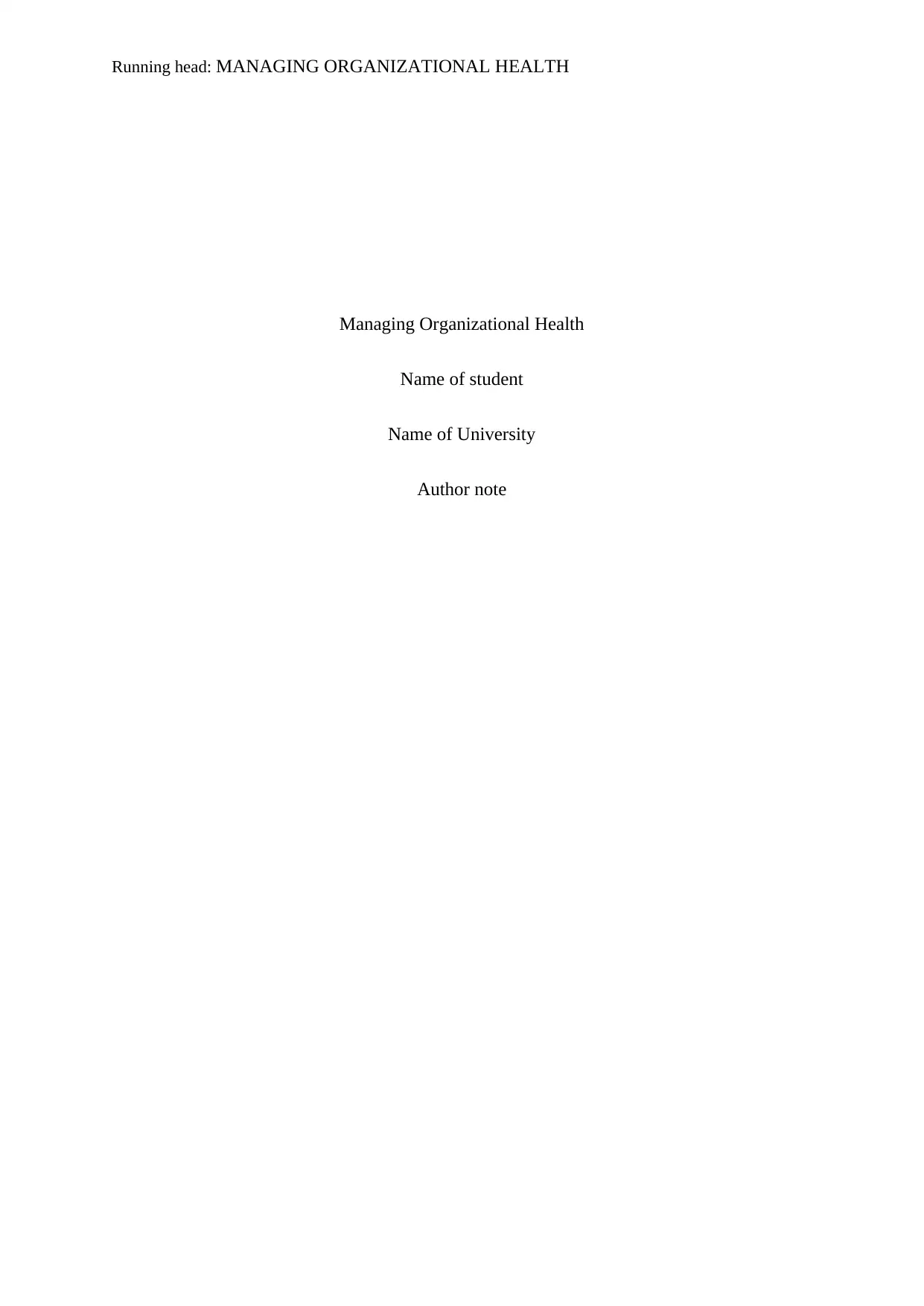
Running head: MANAGING ORGANIZATIONAL HEALTH
Managing Organizational Health
Name of student
Name of University
Author note
Managing Organizational Health
Name of student
Name of University
Author note
Paraphrase This Document
Need a fresh take? Get an instant paraphrase of this document with our AI Paraphraser
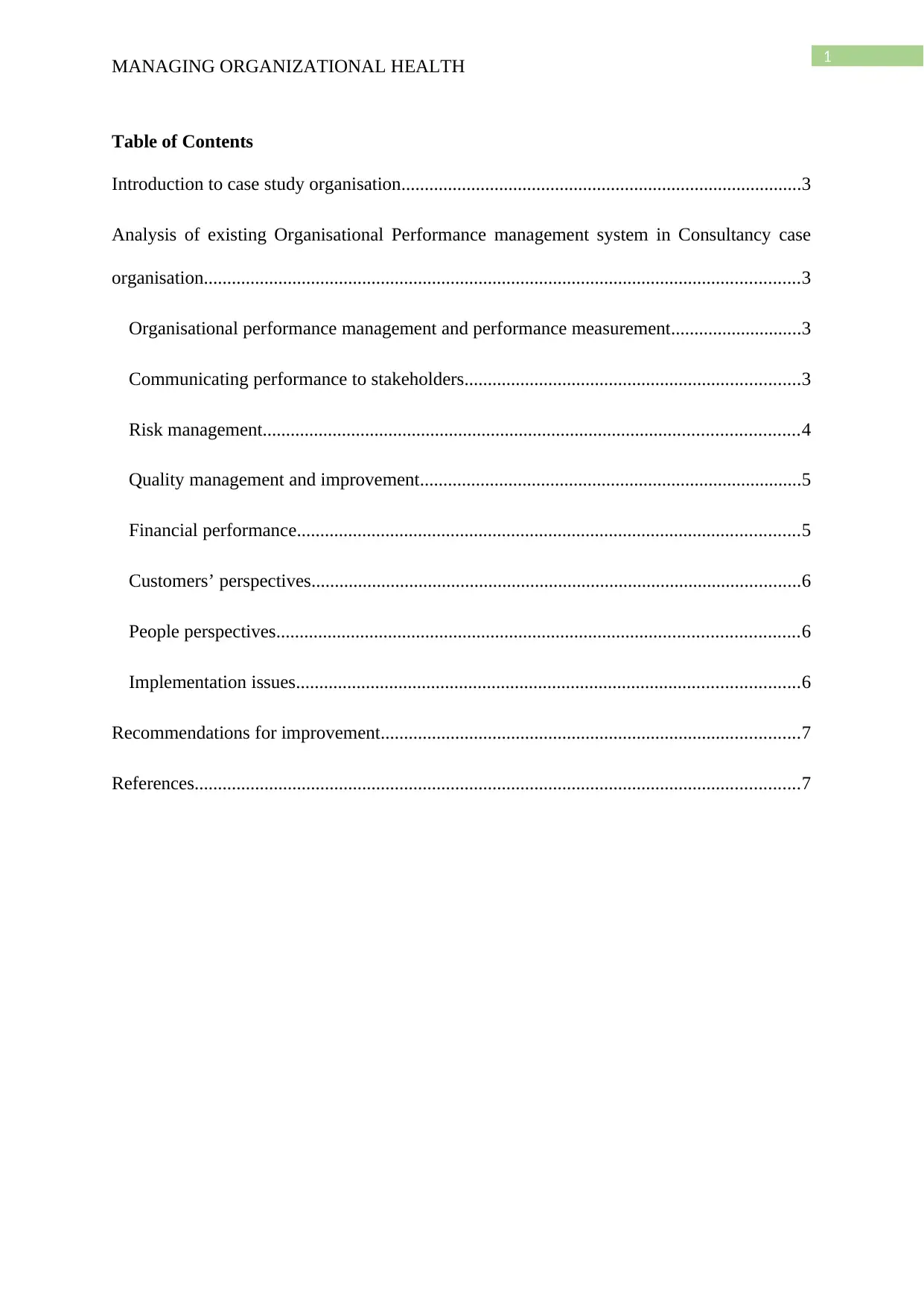
1
MANAGING ORGANIZATIONAL HEALTH
Table of Contents
Introduction to case study organisation......................................................................................3
Analysis of existing Organisational Performance management system in Consultancy case
organisation................................................................................................................................3
Organisational performance management and performance measurement............................3
Communicating performance to stakeholders........................................................................3
Risk management...................................................................................................................4
Quality management and improvement..................................................................................5
Financial performance............................................................................................................5
Customers’ perspectives.........................................................................................................6
People perspectives................................................................................................................6
Implementation issues............................................................................................................6
Recommendations for improvement..........................................................................................7
References..................................................................................................................................7
MANAGING ORGANIZATIONAL HEALTH
Table of Contents
Introduction to case study organisation......................................................................................3
Analysis of existing Organisational Performance management system in Consultancy case
organisation................................................................................................................................3
Organisational performance management and performance measurement............................3
Communicating performance to stakeholders........................................................................3
Risk management...................................................................................................................4
Quality management and improvement..................................................................................5
Financial performance............................................................................................................5
Customers’ perspectives.........................................................................................................6
People perspectives................................................................................................................6
Implementation issues............................................................................................................6
Recommendations for improvement..........................................................................................7
References..................................................................................................................................7

2
MANAGING ORGANIZATIONAL HEALTH
Introduction to case study organisation
The report is based on the existing work, which will demonstrate about preparing a
management consultancy report that can define the present organisational system of
Organizational Performance Management or OPM with the consideration of case study
revolving around Singtel in Europe. It will demonstrate about the pervasive characteristics of
organisational performance management and at the same time, ensure development of proper
strategic plan along with facilitation of communication process, review, evaluation,
monitoring and continuous sensitivity too (Bourne et al. 2013). The topic will also assess the
previous assignment and ensure risk management procedures along with communicating the
performance to stakeholders, furthermore, will also determine the financial performance and
focus on managing improvement and quality enhancement too with the consideration of
human resources management, customers’ services, financial performance assessment, etc
(Mir and Pinnington 2014).
From the European context, the business organisation chosen here is Singtel, also
known as Singapore Telecommunications Limited, which is a major telecommunications
company that delivers telecommunication services, mobile data services and internet services
too. The company is known for its delivery of good quality services such as mobile data,
internet, infocomm technology and also mobile network connections (Singtel.com 2019). The
company has been reputed and established considering its huge contribution to the economy
of the nation as well as satisfied the needs and desires of many stakeholders including the
customers as a whole too.
MANAGING ORGANIZATIONAL HEALTH
Introduction to case study organisation
The report is based on the existing work, which will demonstrate about preparing a
management consultancy report that can define the present organisational system of
Organizational Performance Management or OPM with the consideration of case study
revolving around Singtel in Europe. It will demonstrate about the pervasive characteristics of
organisational performance management and at the same time, ensure development of proper
strategic plan along with facilitation of communication process, review, evaluation,
monitoring and continuous sensitivity too (Bourne et al. 2013). The topic will also assess the
previous assignment and ensure risk management procedures along with communicating the
performance to stakeholders, furthermore, will also determine the financial performance and
focus on managing improvement and quality enhancement too with the consideration of
human resources management, customers’ services, financial performance assessment, etc
(Mir and Pinnington 2014).
From the European context, the business organisation chosen here is Singtel, also
known as Singapore Telecommunications Limited, which is a major telecommunications
company that delivers telecommunication services, mobile data services and internet services
too. The company is known for its delivery of good quality services such as mobile data,
internet, infocomm technology and also mobile network connections (Singtel.com 2019). The
company has been reputed and established considering its huge contribution to the economy
of the nation as well as satisfied the needs and desires of many stakeholders including the
customers as a whole too.
⊘ This is a preview!⊘
Do you want full access?
Subscribe today to unlock all pages.

Trusted by 1+ million students worldwide
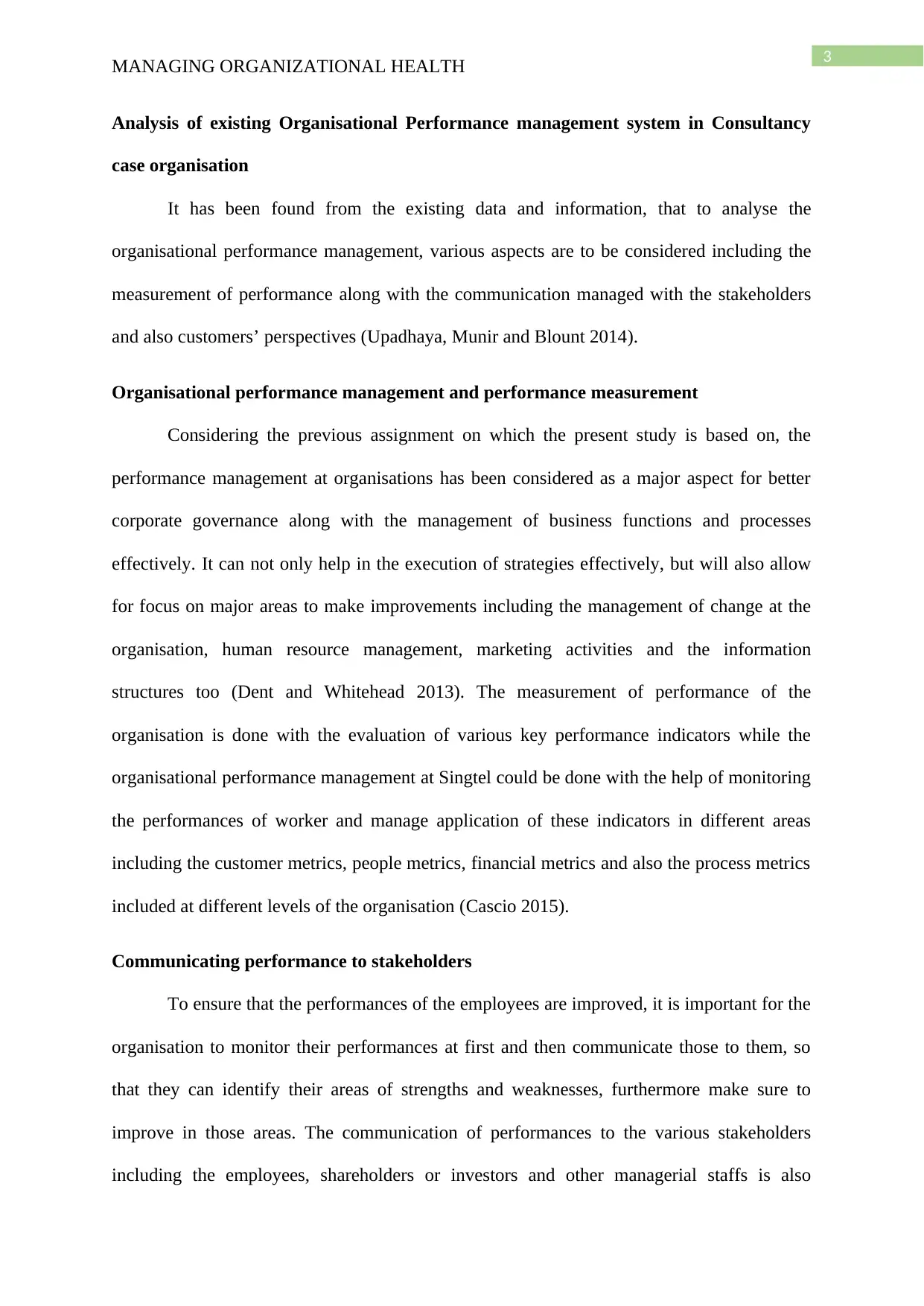
3
MANAGING ORGANIZATIONAL HEALTH
Analysis of existing Organisational Performance management system in Consultancy
case organisation
It has been found from the existing data and information, that to analyse the
organisational performance management, various aspects are to be considered including the
measurement of performance along with the communication managed with the stakeholders
and also customers’ perspectives (Upadhaya, Munir and Blount 2014).
Organisational performance management and performance measurement
Considering the previous assignment on which the present study is based on, the
performance management at organisations has been considered as a major aspect for better
corporate governance along with the management of business functions and processes
effectively. It can not only help in the execution of strategies effectively, but will also allow
for focus on major areas to make improvements including the management of change at the
organisation, human resource management, marketing activities and the information
structures too (Dent and Whitehead 2013). The measurement of performance of the
organisation is done with the evaluation of various key performance indicators while the
organisational performance management at Singtel could be done with the help of monitoring
the performances of worker and manage application of these indicators in different areas
including the customer metrics, people metrics, financial metrics and also the process metrics
included at different levels of the organisation (Cascio 2015).
Communicating performance to stakeholders
To ensure that the performances of the employees are improved, it is important for the
organisation to monitor their performances at first and then communicate those to them, so
that they can identify their areas of strengths and weaknesses, furthermore make sure to
improve in those areas. The communication of performances to the various stakeholders
including the employees, shareholders or investors and other managerial staffs is also
MANAGING ORGANIZATIONAL HEALTH
Analysis of existing Organisational Performance management system in Consultancy
case organisation
It has been found from the existing data and information, that to analyse the
organisational performance management, various aspects are to be considered including the
measurement of performance along with the communication managed with the stakeholders
and also customers’ perspectives (Upadhaya, Munir and Blount 2014).
Organisational performance management and performance measurement
Considering the previous assignment on which the present study is based on, the
performance management at organisations has been considered as a major aspect for better
corporate governance along with the management of business functions and processes
effectively. It can not only help in the execution of strategies effectively, but will also allow
for focus on major areas to make improvements including the management of change at the
organisation, human resource management, marketing activities and the information
structures too (Dent and Whitehead 2013). The measurement of performance of the
organisation is done with the evaluation of various key performance indicators while the
organisational performance management at Singtel could be done with the help of monitoring
the performances of worker and manage application of these indicators in different areas
including the customer metrics, people metrics, financial metrics and also the process metrics
included at different levels of the organisation (Cascio 2015).
Communicating performance to stakeholders
To ensure that the performances of the employees are improved, it is important for the
organisation to monitor their performances at first and then communicate those to them, so
that they can identify their areas of strengths and weaknesses, furthermore make sure to
improve in those areas. The communication of performances to the various stakeholders
including the employees, shareholders or investors and other managerial staffs is also
Paraphrase This Document
Need a fresh take? Get an instant paraphrase of this document with our AI Paraphraser
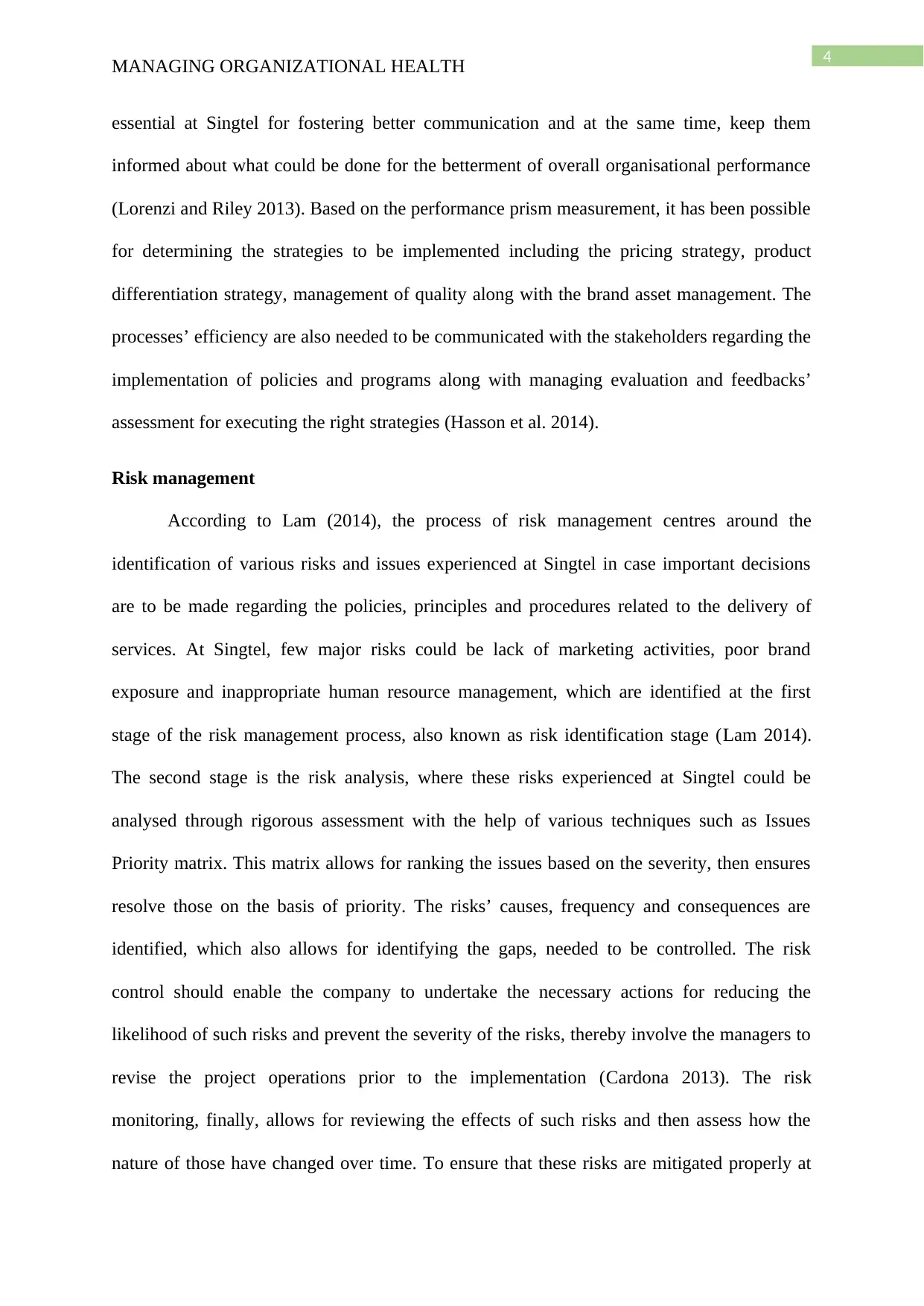
4
MANAGING ORGANIZATIONAL HEALTH
essential at Singtel for fostering better communication and at the same time, keep them
informed about what could be done for the betterment of overall organisational performance
(Lorenzi and Riley 2013). Based on the performance prism measurement, it has been possible
for determining the strategies to be implemented including the pricing strategy, product
differentiation strategy, management of quality along with the brand asset management. The
processes’ efficiency are also needed to be communicated with the stakeholders regarding the
implementation of policies and programs along with managing evaluation and feedbacks’
assessment for executing the right strategies (Hasson et al. 2014).
Risk management
According to Lam (2014), the process of risk management centres around the
identification of various risks and issues experienced at Singtel in case important decisions
are to be made regarding the policies, principles and procedures related to the delivery of
services. At Singtel, few major risks could be lack of marketing activities, poor brand
exposure and inappropriate human resource management, which are identified at the first
stage of the risk management process, also known as risk identification stage (Lam 2014).
The second stage is the risk analysis, where these risks experienced at Singtel could be
analysed through rigorous assessment with the help of various techniques such as Issues
Priority matrix. This matrix allows for ranking the issues based on the severity, then ensures
resolve those on the basis of priority. The risks’ causes, frequency and consequences are
identified, which also allows for identifying the gaps, needed to be controlled. The risk
control should enable the company to undertake the necessary actions for reducing the
likelihood of such risks and prevent the severity of the risks, thereby involve the managers to
revise the project operations prior to the implementation (Cardona 2013). The risk
monitoring, finally, allows for reviewing the effects of such risks and then assess how the
nature of those have changed over time. To ensure that these risks are mitigated properly at
MANAGING ORGANIZATIONAL HEALTH
essential at Singtel for fostering better communication and at the same time, keep them
informed about what could be done for the betterment of overall organisational performance
(Lorenzi and Riley 2013). Based on the performance prism measurement, it has been possible
for determining the strategies to be implemented including the pricing strategy, product
differentiation strategy, management of quality along with the brand asset management. The
processes’ efficiency are also needed to be communicated with the stakeholders regarding the
implementation of policies and programs along with managing evaluation and feedbacks’
assessment for executing the right strategies (Hasson et al. 2014).
Risk management
According to Lam (2014), the process of risk management centres around the
identification of various risks and issues experienced at Singtel in case important decisions
are to be made regarding the policies, principles and procedures related to the delivery of
services. At Singtel, few major risks could be lack of marketing activities, poor brand
exposure and inappropriate human resource management, which are identified at the first
stage of the risk management process, also known as risk identification stage (Lam 2014).
The second stage is the risk analysis, where these risks experienced at Singtel could be
analysed through rigorous assessment with the help of various techniques such as Issues
Priority matrix. This matrix allows for ranking the issues based on the severity, then ensures
resolve those on the basis of priority. The risks’ causes, frequency and consequences are
identified, which also allows for identifying the gaps, needed to be controlled. The risk
control should enable the company to undertake the necessary actions for reducing the
likelihood of such risks and prevent the severity of the risks, thereby involve the managers to
revise the project operations prior to the implementation (Cardona 2013). The risk
monitoring, finally, allows for reviewing the effects of such risks and then assess how the
nature of those have changed over time. To ensure that these risks are mitigated properly at
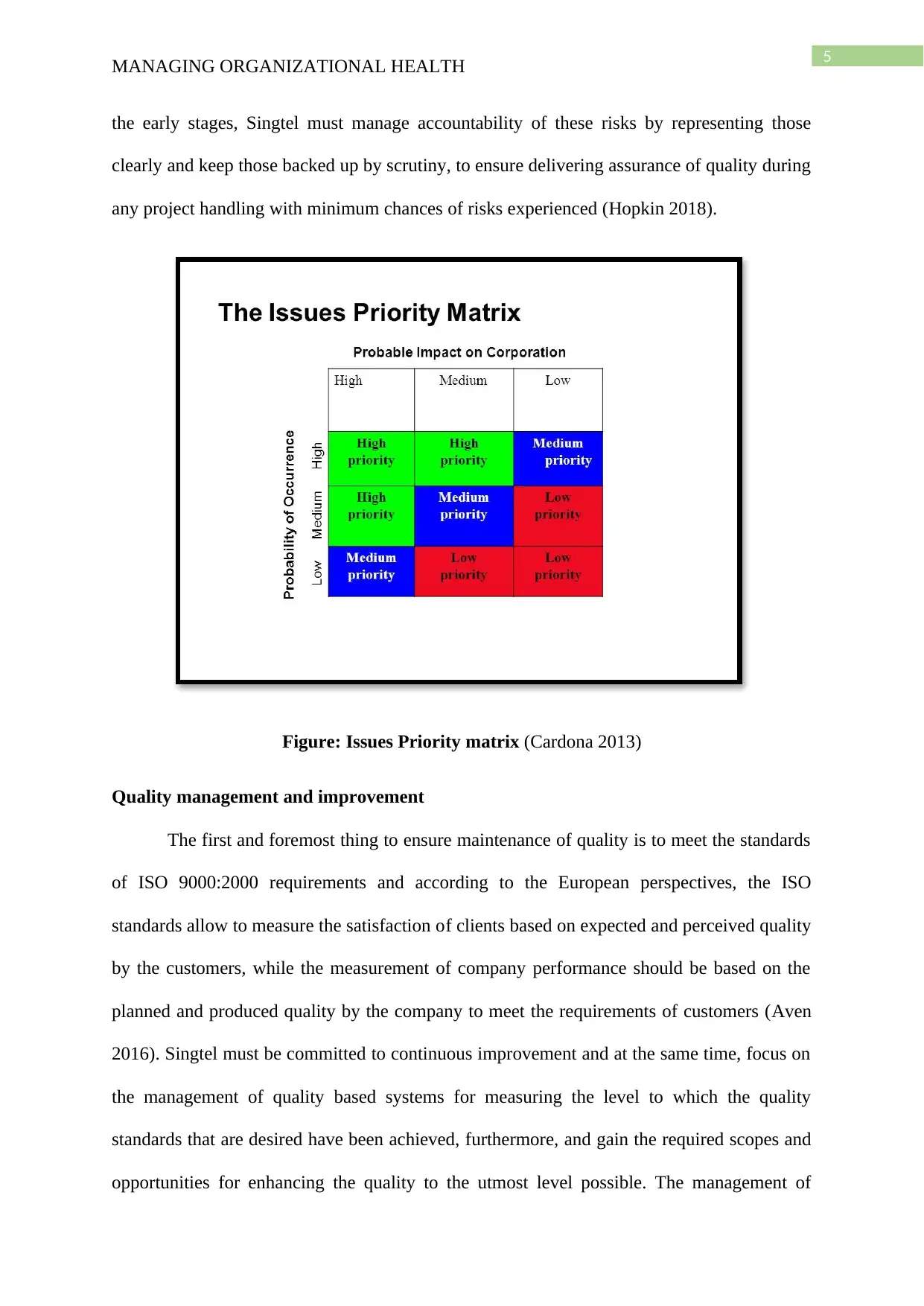
5
MANAGING ORGANIZATIONAL HEALTH
the early stages, Singtel must manage accountability of these risks by representing those
clearly and keep those backed up by scrutiny, to ensure delivering assurance of quality during
any project handling with minimum chances of risks experienced (Hopkin 2018).
Figure: Issues Priority matrix (Cardona 2013)
Quality management and improvement
The first and foremost thing to ensure maintenance of quality is to meet the standards
of ISO 9000:2000 requirements and according to the European perspectives, the ISO
standards allow to measure the satisfaction of clients based on expected and perceived quality
by the customers, while the measurement of company performance should be based on the
planned and produced quality by the company to meet the requirements of customers (Aven
2016). Singtel must be committed to continuous improvement and at the same time, focus on
the management of quality based systems for measuring the level to which the quality
standards that are desired have been achieved, furthermore, and gain the required scopes and
opportunities for enhancing the quality to the utmost level possible. The management of
MANAGING ORGANIZATIONAL HEALTH
the early stages, Singtel must manage accountability of these risks by representing those
clearly and keep those backed up by scrutiny, to ensure delivering assurance of quality during
any project handling with minimum chances of risks experienced (Hopkin 2018).
Figure: Issues Priority matrix (Cardona 2013)
Quality management and improvement
The first and foremost thing to ensure maintenance of quality is to meet the standards
of ISO 9000:2000 requirements and according to the European perspectives, the ISO
standards allow to measure the satisfaction of clients based on expected and perceived quality
by the customers, while the measurement of company performance should be based on the
planned and produced quality by the company to meet the requirements of customers (Aven
2016). Singtel must be committed to continuous improvement and at the same time, focus on
the management of quality based systems for measuring the level to which the quality
standards that are desired have been achieved, furthermore, and gain the required scopes and
opportunities for enhancing the quality to the utmost level possible. The management of
⊘ This is a preview!⊘
Do you want full access?
Subscribe today to unlock all pages.

Trusted by 1+ million students worldwide
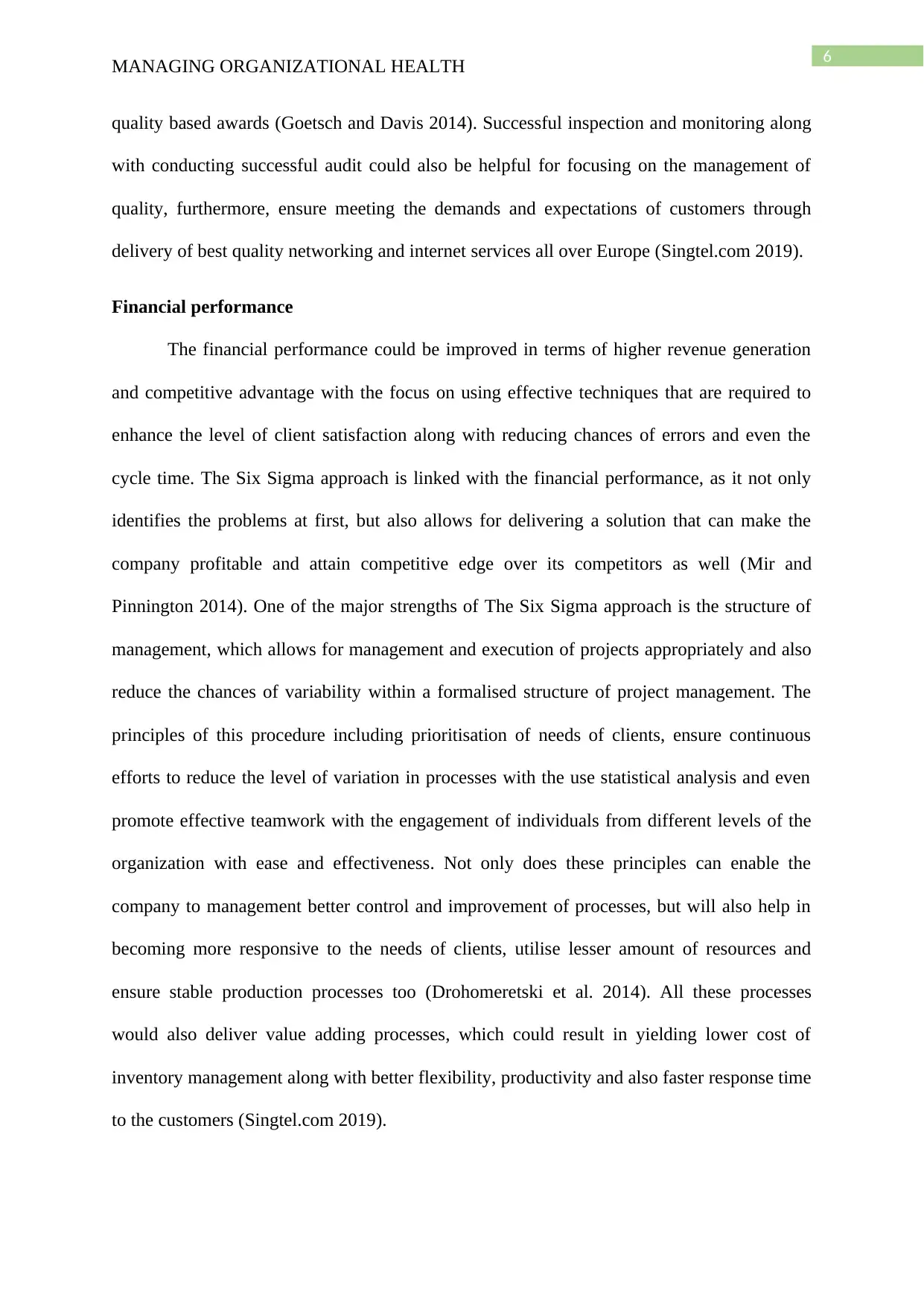
6
MANAGING ORGANIZATIONAL HEALTH
quality based awards (Goetsch and Davis 2014). Successful inspection and monitoring along
with conducting successful audit could also be helpful for focusing on the management of
quality, furthermore, ensure meeting the demands and expectations of customers through
delivery of best quality networking and internet services all over Europe (Singtel.com 2019).
Financial performance
The financial performance could be improved in terms of higher revenue generation
and competitive advantage with the focus on using effective techniques that are required to
enhance the level of client satisfaction along with reducing chances of errors and even the
cycle time. The Six Sigma approach is linked with the financial performance, as it not only
identifies the problems at first, but also allows for delivering a solution that can make the
company profitable and attain competitive edge over its competitors as well (Mir and
Pinnington 2014). One of the major strengths of The Six Sigma approach is the structure of
management, which allows for management and execution of projects appropriately and also
reduce the chances of variability within a formalised structure of project management. The
principles of this procedure including prioritisation of needs of clients, ensure continuous
efforts to reduce the level of variation in processes with the use statistical analysis and even
promote effective teamwork with the engagement of individuals from different levels of the
organization with ease and effectiveness. Not only does these principles can enable the
company to management better control and improvement of processes, but will also help in
becoming more responsive to the needs of clients, utilise lesser amount of resources and
ensure stable production processes too (Drohomeretski et al. 2014). All these processes
would also deliver value adding processes, which could result in yielding lower cost of
inventory management along with better flexibility, productivity and also faster response time
to the customers (Singtel.com 2019).
MANAGING ORGANIZATIONAL HEALTH
quality based awards (Goetsch and Davis 2014). Successful inspection and monitoring along
with conducting successful audit could also be helpful for focusing on the management of
quality, furthermore, ensure meeting the demands and expectations of customers through
delivery of best quality networking and internet services all over Europe (Singtel.com 2019).
Financial performance
The financial performance could be improved in terms of higher revenue generation
and competitive advantage with the focus on using effective techniques that are required to
enhance the level of client satisfaction along with reducing chances of errors and even the
cycle time. The Six Sigma approach is linked with the financial performance, as it not only
identifies the problems at first, but also allows for delivering a solution that can make the
company profitable and attain competitive edge over its competitors as well (Mir and
Pinnington 2014). One of the major strengths of The Six Sigma approach is the structure of
management, which allows for management and execution of projects appropriately and also
reduce the chances of variability within a formalised structure of project management. The
principles of this procedure including prioritisation of needs of clients, ensure continuous
efforts to reduce the level of variation in processes with the use statistical analysis and even
promote effective teamwork with the engagement of individuals from different levels of the
organization with ease and effectiveness. Not only does these principles can enable the
company to management better control and improvement of processes, but will also help in
becoming more responsive to the needs of clients, utilise lesser amount of resources and
ensure stable production processes too (Drohomeretski et al. 2014). All these processes
would also deliver value adding processes, which could result in yielding lower cost of
inventory management along with better flexibility, productivity and also faster response time
to the customers (Singtel.com 2019).
Paraphrase This Document
Need a fresh take? Get an instant paraphrase of this document with our AI Paraphraser
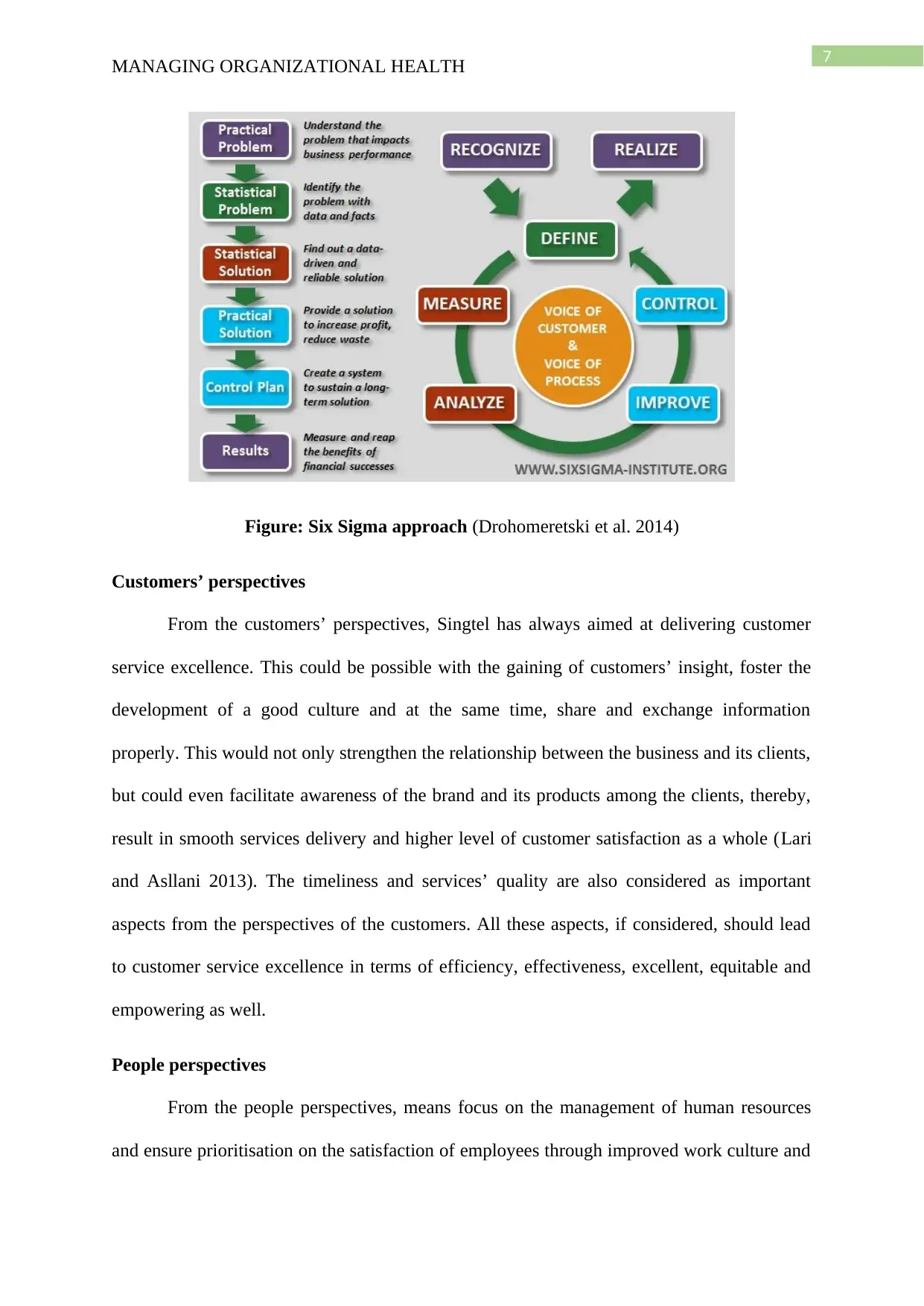
7
MANAGING ORGANIZATIONAL HEALTH
Figure: Six Sigma approach (Drohomeretski et al. 2014)
Customers’ perspectives
From the customers’ perspectives, Singtel has always aimed at delivering customer
service excellence. This could be possible with the gaining of customers’ insight, foster the
development of a good culture and at the same time, share and exchange information
properly. This would not only strengthen the relationship between the business and its clients,
but could even facilitate awareness of the brand and its products among the clients, thereby,
result in smooth services delivery and higher level of customer satisfaction as a whole (Lari
and Asllani 2013). The timeliness and services’ quality are also considered as important
aspects from the perspectives of the customers. All these aspects, if considered, should lead
to customer service excellence in terms of efficiency, effectiveness, excellent, equitable and
empowering as well.
People perspectives
From the people perspectives, means focus on the management of human resources
and ensure prioritisation on the satisfaction of employees through improved work culture and
MANAGING ORGANIZATIONAL HEALTH
Figure: Six Sigma approach (Drohomeretski et al. 2014)
Customers’ perspectives
From the customers’ perspectives, Singtel has always aimed at delivering customer
service excellence. This could be possible with the gaining of customers’ insight, foster the
development of a good culture and at the same time, share and exchange information
properly. This would not only strengthen the relationship between the business and its clients,
but could even facilitate awareness of the brand and its products among the clients, thereby,
result in smooth services delivery and higher level of customer satisfaction as a whole (Lari
and Asllani 2013). The timeliness and services’ quality are also considered as important
aspects from the perspectives of the customers. All these aspects, if considered, should lead
to customer service excellence in terms of efficiency, effectiveness, excellent, equitable and
empowering as well.
People perspectives
From the people perspectives, means focus on the management of human resources
and ensure prioritisation on the satisfaction of employees through improved work culture and
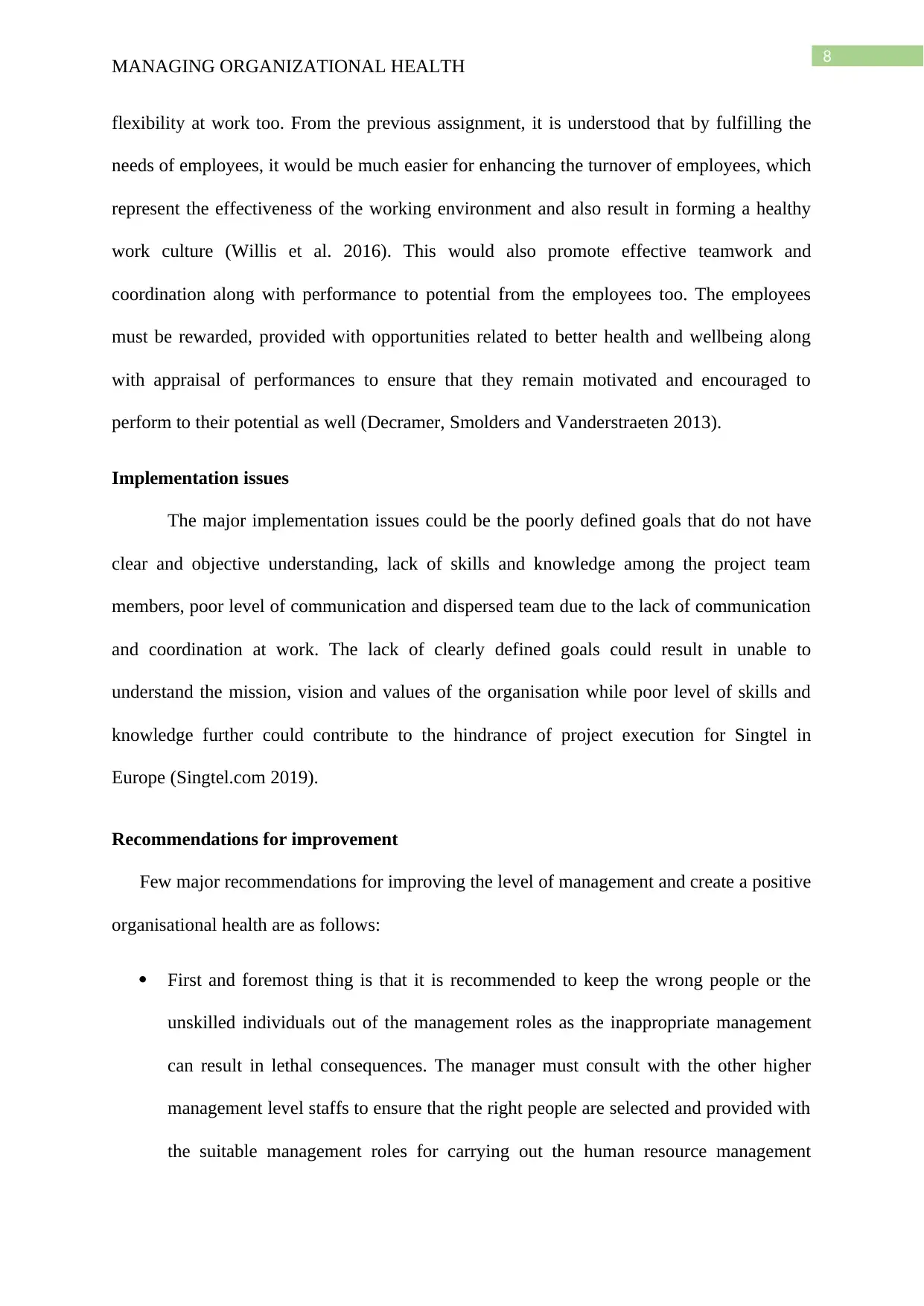
8
MANAGING ORGANIZATIONAL HEALTH
flexibility at work too. From the previous assignment, it is understood that by fulfilling the
needs of employees, it would be much easier for enhancing the turnover of employees, which
represent the effectiveness of the working environment and also result in forming a healthy
work culture (Willis et al. 2016). This would also promote effective teamwork and
coordination along with performance to potential from the employees too. The employees
must be rewarded, provided with opportunities related to better health and wellbeing along
with appraisal of performances to ensure that they remain motivated and encouraged to
perform to their potential as well (Decramer, Smolders and Vanderstraeten 2013).
Implementation issues
The major implementation issues could be the poorly defined goals that do not have
clear and objective understanding, lack of skills and knowledge among the project team
members, poor level of communication and dispersed team due to the lack of communication
and coordination at work. The lack of clearly defined goals could result in unable to
understand the mission, vision and values of the organisation while poor level of skills and
knowledge further could contribute to the hindrance of project execution for Singtel in
Europe (Singtel.com 2019).
Recommendations for improvement
Few major recommendations for improving the level of management and create a positive
organisational health are as follows:
First and foremost thing is that it is recommended to keep the wrong people or the
unskilled individuals out of the management roles as the inappropriate management
can result in lethal consequences. The manager must consult with the other higher
management level staffs to ensure that the right people are selected and provided with
the suitable management roles for carrying out the human resource management
MANAGING ORGANIZATIONAL HEALTH
flexibility at work too. From the previous assignment, it is understood that by fulfilling the
needs of employees, it would be much easier for enhancing the turnover of employees, which
represent the effectiveness of the working environment and also result in forming a healthy
work culture (Willis et al. 2016). This would also promote effective teamwork and
coordination along with performance to potential from the employees too. The employees
must be rewarded, provided with opportunities related to better health and wellbeing along
with appraisal of performances to ensure that they remain motivated and encouraged to
perform to their potential as well (Decramer, Smolders and Vanderstraeten 2013).
Implementation issues
The major implementation issues could be the poorly defined goals that do not have
clear and objective understanding, lack of skills and knowledge among the project team
members, poor level of communication and dispersed team due to the lack of communication
and coordination at work. The lack of clearly defined goals could result in unable to
understand the mission, vision and values of the organisation while poor level of skills and
knowledge further could contribute to the hindrance of project execution for Singtel in
Europe (Singtel.com 2019).
Recommendations for improvement
Few major recommendations for improving the level of management and create a positive
organisational health are as follows:
First and foremost thing is that it is recommended to keep the wrong people or the
unskilled individuals out of the management roles as the inappropriate management
can result in lethal consequences. The manager must consult with the other higher
management level staffs to ensure that the right people are selected and provided with
the suitable management roles for carrying out the human resource management
⊘ This is a preview!⊘
Do you want full access?
Subscribe today to unlock all pages.

Trusted by 1+ million students worldwide

9
MANAGING ORGANIZATIONAL HEALTH
practices effectively, furthermore bring improved organisational performance and
restore positive health through development of a good culture and working
environment too.
It is recommended to craft the design of job in an appropriate way for increasing the
level of engagement of employees and meet the necessary standards and requirements
for a successful workforce. This could be beneficial for Singtel in Europe to make
good decision for making the employees stay healthy and at the same time, create
better scopes and opportunities for the people to thrive and excel in terms of
performance.
The HR manager must also design a stellar on boarding experience and ensure
recruitment and selection of right candidates, prioritise on their growth and
development and even manage diversity at workplace.
It is also recommended for the business organisation to communicate the employees
regarding the clear mission, vision, goals and set of values required to maintain
transparency, openness and integrity within the workplace
The management of reward systems and appraisal of the performances of employees
are recommended too for the purpose of establishing a great corporate culture that can
make employees engaged, motivated and encouraged to work collaboratively and as a
team
Creating opportunities for enhancing the inclusiveness is recommended at Singtel in
Europe for engaging more people from various levels of the organisations,
furthermore, allow them to share their individual thoughts, ideas, views and opinions
prior to the process of decision making.
The TQM or Total Quality Management approach is recommended as well for
focusing on the quality of business operations and processes and ensure enhancing the
MANAGING ORGANIZATIONAL HEALTH
practices effectively, furthermore bring improved organisational performance and
restore positive health through development of a good culture and working
environment too.
It is recommended to craft the design of job in an appropriate way for increasing the
level of engagement of employees and meet the necessary standards and requirements
for a successful workforce. This could be beneficial for Singtel in Europe to make
good decision for making the employees stay healthy and at the same time, create
better scopes and opportunities for the people to thrive and excel in terms of
performance.
The HR manager must also design a stellar on boarding experience and ensure
recruitment and selection of right candidates, prioritise on their growth and
development and even manage diversity at workplace.
It is also recommended for the business organisation to communicate the employees
regarding the clear mission, vision, goals and set of values required to maintain
transparency, openness and integrity within the workplace
The management of reward systems and appraisal of the performances of employees
are recommended too for the purpose of establishing a great corporate culture that can
make employees engaged, motivated and encouraged to work collaboratively and as a
team
Creating opportunities for enhancing the inclusiveness is recommended at Singtel in
Europe for engaging more people from various levels of the organisations,
furthermore, allow them to share their individual thoughts, ideas, views and opinions
prior to the process of decision making.
The TQM or Total Quality Management approach is recommended as well for
focusing on the quality of business operations and processes and ensure enhancing the
Paraphrase This Document
Need a fresh take? Get an instant paraphrase of this document with our AI Paraphraser
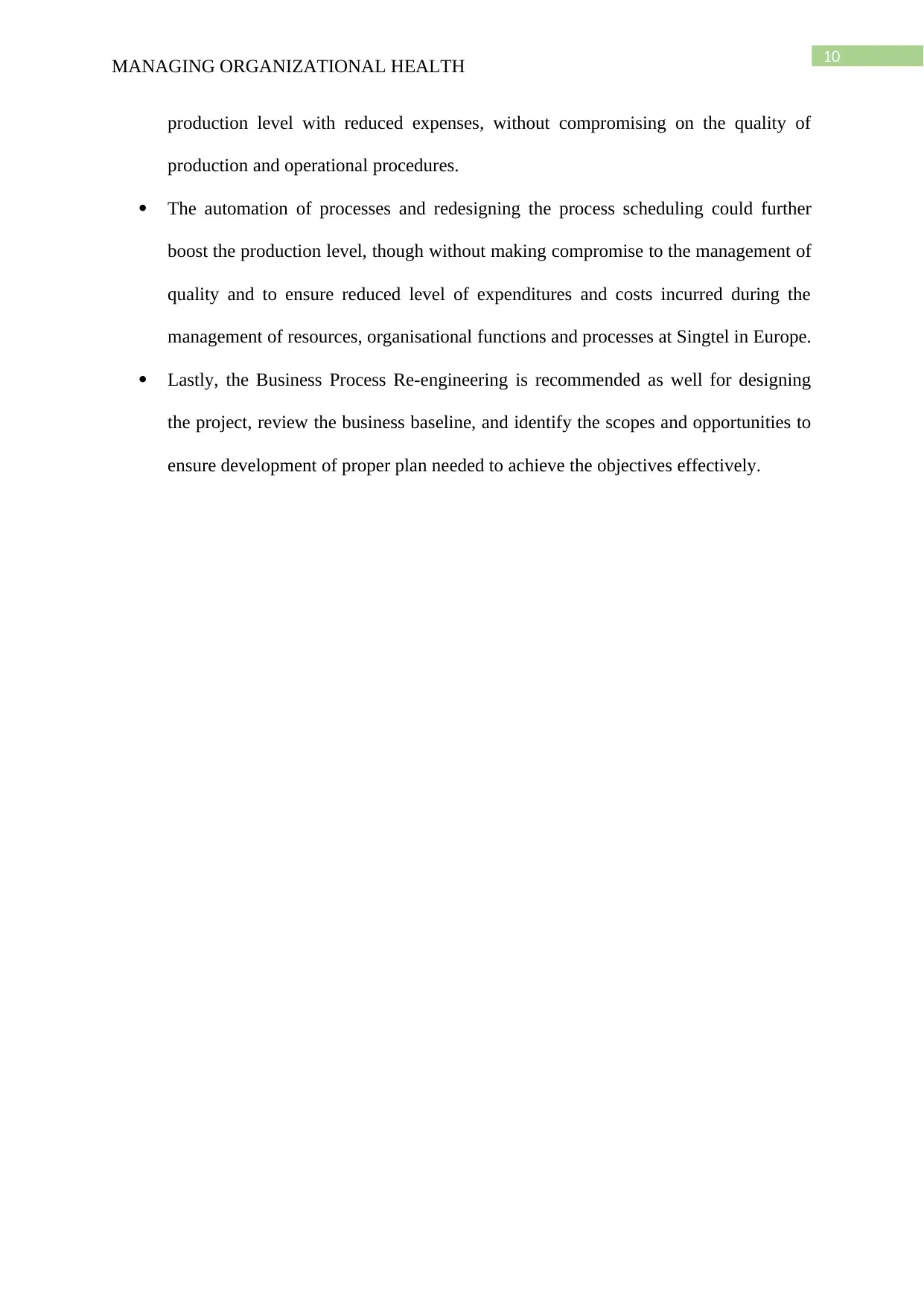
10
MANAGING ORGANIZATIONAL HEALTH
production level with reduced expenses, without compromising on the quality of
production and operational procedures.
The automation of processes and redesigning the process scheduling could further
boost the production level, though without making compromise to the management of
quality and to ensure reduced level of expenditures and costs incurred during the
management of resources, organisational functions and processes at Singtel in Europe.
Lastly, the Business Process Re-engineering is recommended as well for designing
the project, review the business baseline, and identify the scopes and opportunities to
ensure development of proper plan needed to achieve the objectives effectively.
MANAGING ORGANIZATIONAL HEALTH
production level with reduced expenses, without compromising on the quality of
production and operational procedures.
The automation of processes and redesigning the process scheduling could further
boost the production level, though without making compromise to the management of
quality and to ensure reduced level of expenditures and costs incurred during the
management of resources, organisational functions and processes at Singtel in Europe.
Lastly, the Business Process Re-engineering is recommended as well for designing
the project, review the business baseline, and identify the scopes and opportunities to
ensure development of proper plan needed to achieve the objectives effectively.

11
MANAGING ORGANIZATIONAL HEALTH
References
Aven, T., 2016. Risk assessment and risk management: Review of recent advances on their
foundation. European Journal of Operational Research, 253(1), pp.1-13.
Bourne, M., Pavlov, A., Franco-Santos, M., Lucianetti, L. and Mura, M., 2013. Generating
organisational performance: The contributing effects of performance measurement and
human resource management practices. International Journal of Operations & Production
Management, 33(11/12), pp.1599-1622.
Cardona, O.D., 2013. The need for rethinking the concepts of vulnerability and risk from a
holistic perspective: a necessary review and criticism for effective risk management.
In Mapping vulnerability (pp. 56-70). Routledge.
Cascio, W.F., 2015. Managing human resources. McGraw-Hill.
Decramer, A., Smolders, C. and Vanderstraeten, A., 2013. Employee performance
management culture and system features in higher education: relationship with employee
performance management satisfaction. The International Journal of Human Resource
Management, 24(2), pp.352-371.
Dent, M. and Whitehead, S. eds., 2013. Managing professional identities: Knowledge,
performativities and the'new'professional (Vol. 19). Routledge.
Drohomeretski, E., Gouvea da Costa, S.E., Pinheiro de Lima, E. and Garbuio, P.A.D.R.,
2014. Lean, Six Sigma and Lean Six Sigma: an analysis based on operations
strategy. International Journal of Production Research, 52(3), pp.804-824.
Goetsch, D.L. and Davis, S., 2014. Quality management for organizational excellence:
Introduction to total quality.
MANAGING ORGANIZATIONAL HEALTH
References
Aven, T., 2016. Risk assessment and risk management: Review of recent advances on their
foundation. European Journal of Operational Research, 253(1), pp.1-13.
Bourne, M., Pavlov, A., Franco-Santos, M., Lucianetti, L. and Mura, M., 2013. Generating
organisational performance: The contributing effects of performance measurement and
human resource management practices. International Journal of Operations & Production
Management, 33(11/12), pp.1599-1622.
Cardona, O.D., 2013. The need for rethinking the concepts of vulnerability and risk from a
holistic perspective: a necessary review and criticism for effective risk management.
In Mapping vulnerability (pp. 56-70). Routledge.
Cascio, W.F., 2015. Managing human resources. McGraw-Hill.
Decramer, A., Smolders, C. and Vanderstraeten, A., 2013. Employee performance
management culture and system features in higher education: relationship with employee
performance management satisfaction. The International Journal of Human Resource
Management, 24(2), pp.352-371.
Dent, M. and Whitehead, S. eds., 2013. Managing professional identities: Knowledge,
performativities and the'new'professional (Vol. 19). Routledge.
Drohomeretski, E., Gouvea da Costa, S.E., Pinheiro de Lima, E. and Garbuio, P.A.D.R.,
2014. Lean, Six Sigma and Lean Six Sigma: an analysis based on operations
strategy. International Journal of Production Research, 52(3), pp.804-824.
Goetsch, D.L. and Davis, S., 2014. Quality management for organizational excellence:
Introduction to total quality.
⊘ This is a preview!⊘
Do you want full access?
Subscribe today to unlock all pages.

Trusted by 1+ million students worldwide
1 out of 13
Related Documents
Your All-in-One AI-Powered Toolkit for Academic Success.
+13062052269
info@desklib.com
Available 24*7 on WhatsApp / Email
![[object Object]](/_next/static/media/star-bottom.7253800d.svg)
Unlock your academic potential
Copyright © 2020–2025 A2Z Services. All Rights Reserved. Developed and managed by ZUCOL.




